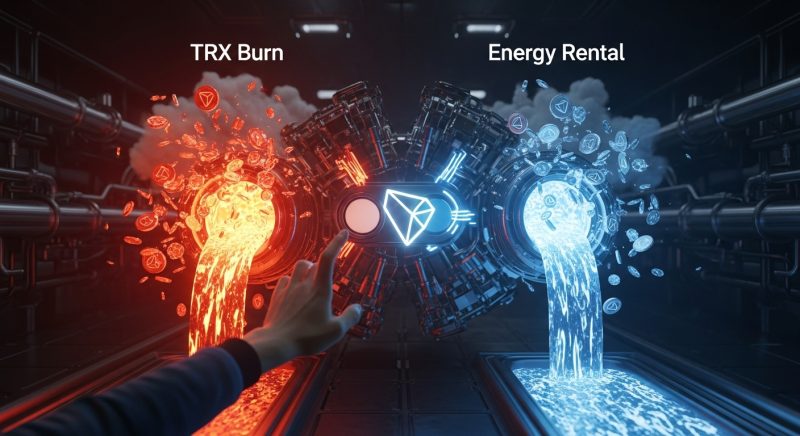Sooner or later, most TRON users face the same situation. You try to send USDT, and the wallet suddenly shows an error saying there isn’t enough TRX. At first, it feels confusing, and it may even seem like a glitch. In reality, the blockchain simply needs a resource called tron energy to process your transaction. This isn’t a bug or an extra charge. It’s the mechanism that helps the TRON network stay fast and reliable.
How the TRON Network Actually Works
TRON operates on a distinct principle compared to Ethereum or BNB Chain, as it doesn’t depend on fluctuating gas charges. The protocol employs an internal resource mechanism that maintains consistency. Each time you transfer USDT or interact with a smart contract, the blockchain consumes a portion of computational capacity and data throughput to register your operation.
When your address exhausts these allocated resources, the protocol automatically destroys a minimal quantity of TRX to finalize the operation. This explains why your holdings may decrease even when you’re solely transferring stablecoins.
This model ensures TRON remains swift and reliable regardless of network congestion levels. Transaction expenses stay constant, enabling millions of operations to be handled daily without performance degradation.
Why Each Transfer Requires Power
Every transaction on the TRON network requires a certain amount of internal resources to process. Sending USDT to a wallet that already holds the token uses fewer resources than sending to a wallet that doesn’t have any USDT yet. If your wallet has enough of these resources stored, the transfer goes through smoothly without spending TRX. When they run out, the system burns a small amount of TRX to finish the operation.
At an average price of about $0.29 per TRX, a typical transfer costs between two and four dollars. For a single user, that’s manageable, but for traders, exchanges, or companies handling many payments each day, these costs can quickly become significant.
The Problem for Active Users
For frequent senders, there’s a hidden burden: the need to constantly replenish TRX just to keep transfers running. Many users only realize this after seeing “insufficient balance” errors in the middle of a payment.
It’s not just frustrating — it interrupts business operations and makes budgeting unpredictable. Because TRX is burned directly with every transaction, you can’t easily control when your costs will spike. That’s why the concept of renting Energy became so important within the TRON ecosystem.
Leasing Rather Than Destroying
Initially, TRON participants could acquire Power solely by staking TRX within their address. This required immobilizing tokens for multiple days, which proved impractical for individuals requiring fluid capital access. Power leasing transformed this scenario entirely.
Via specialized platforms, you can remit a modest sum once and immediately receive Power linked to your address. No staking occurs, no waiting interval exists, and no manual administration is necessary. Operations become foreseeable, and the volume of TRX destroyed plummets significantly — frequently by 65% or beyond.
How Tron Pool Energy Simplifies Everything
Among available platforms, Tron Pool Energy has emerged as the most reliable service for leasing resources. It operates swiftly, maintains full transparency, and prioritizes security at every level. You merely supply your public address — never private credentials — and the system assigns Power directly to your account.
What users appreciate most are the consistent results:
- Average savings of up to 65% on TRC-20 transfer fees.
- Unlimited Energy duration, so you don’t need to renew it every few days.
- Works with all non-custodial wallets supporting USDT TRC-20.
- Connect up to 30 wallets under one account.
- Round-the-clock support, helpful for both individuals and businesses.
This setup transforms how people interact with the TRON blockchain. Instead of thinking about TRX balances, users just send transactions — the system takes care of the rest automatically.
The Function of “Unrestricted Power”
For enterprises executing daily disbursements, Tron Pool Energy provides a distinctive “Unrestricted Power” feature. It allocates the necessary volume of Power and Throughput for each operation, ensuring continuity even when the address balance reaches nil.
This eliminates recurring TRX acquisitions, operational interruptions, and unexpected expense spikes. For organizations coordinating salary distributions or peer-to-peer platforms processing thousands of transfers, such consistency delivers tangible improvements in both expenditure management and operational flow.
Why This Matters
TRON Power represents more than a mere technical specification. It constitutes a novel financial framework within the distributed ledger, one that incentivizes optimization rather than excess consumption. By isolating Power and Throughput from token valuation fluctuations, TRON established an infrastructure where participants can regulate their spending patterns and frequency.
Platforms like Tron Pool Energy actualize this concept. They eliminate manual resource oversight, slash expenses substantially, and maintain complete transaction visibility on the public ledger.
Closing Remarks
Grasping TRON Power is fundamental to understanding the network’s operational logic. Once you recognize that every operation depends on quantifiable resources, you gain complete authority over your expenditures.
Leasing Power via Tron Pool Energy delivers the autonomy to move USDT without concern for TRX deficits, configuration complexities, or volatile charges. It’s streamlined, protected, and designed for contemporary digital asset commerce — precisely how distributed ledger technology was intended to function.








